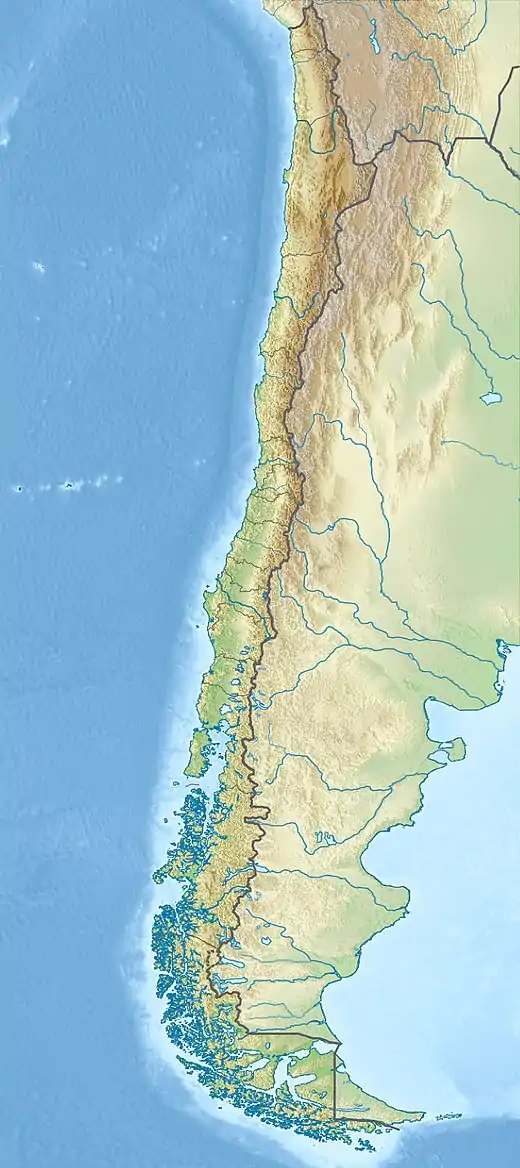Telmatobius halli
Telmatobius halli is a species of frog in the family Telmatobiidae. It is endemic to northern Chile and only known from its type locality near Ollagüe.[1][3] The specific name halli honors Frank Gregory Hall, an American specialist on the effects of high altitudes on human body[4] and collector of the type series.[2] Its common name is Hall's water frog.[1][3][4]
| Telmatobius halli | |
|---|---|
| Scientific classification | |
| Kingdom: | Animalia |
| Phylum: | Chordata |
| Class: | Amphibia |
| Order: | Anura |
| Family: | Telmatobiidae |
| Genus: | Telmatobius |
| Species: | T. halli |
| Binomial name | |
| Telmatobius halli | |
Description
The type series includes six adult females measuring 42–57 mm (1.7–2.2 in) in snout–vent length. No males were collected.[2] The head is narrower than the body but broader than it is long. The snout is truncate in dorsal view. No tympanum is present and the supratympanic fold is barely visible. The fingers have rounded tips and no webbing, but have rudimentary lateral fringes. The toes have rounded tips and are extensively webbed. Preserved specimens have uniformly brown to tan The dorsum. There are minute paler specks on the flanks. The venter is pale cream. The finger and toe tips are yellow. Color in life is unknown.[5]
The largest tadpoles are 83 mm (3.3 in) in total length and have long, pointed tails.[2]
Telmatobius halli are strictly aquatic and can survive on land for only five minutes.[6]

Habitat and conservation
Telmatobius halli is only known from its type series,[1] which was collected in 1935 in a hot spring at 3,000 m (10,000 ft) above sea level[2] (contemporary sources give altitude as 3,700 m (12,100 ft)[5] or 2,000–3,400 m (6,600–11,200 ft)[1]). Over the years, a number of searches were conducted, but no new specimens could be found.[1] In 2020, a Telmatobius halli was found in a tiny hot spring oasis near Ollagüe in Chile's Atacama desert.[6]
References
- IUCN SSC Amphibian Specialist Group (2015). "Telmatobius halli". IUCN Red List of Threatened Species. 2015: e.T21582A79809691. doi:10.2305/IUCN.UK.2015-4.RLTS.T21582A79809691.en.
- Noble, Gladwyn Kingsley (1938). "A new species of frog of the genus Telmatobius from Chile". American Museum Novitates. 973: 1–3.
- Frost, Darrel R. (2018). "Telmatobius halli Noble, 1938". Amphibian Species of the World: an Online Reference. Version 6.0. American Museum of Natural History. Retrieved 3 May 2018.
- Beolens, Bo; Watkins, Michael & Grayson, Michael (2013). The Eponym Dictionary of Amphibians. Pelagic Publishing. p. 88. ISBN 978-1-907807-42-8.
- Formas, J. Ramón; Benavides, Edgar & Cuevas, César (2003). "A new species of Telmatobius (Anura: Leptodactylidae) from Río Vilama, northern Chile, and the redescription of T. halli Noble". Herpetologica. 59 (2): 253–270. doi:10.1655/0018-0831(2003)059[0253:ANSOTA]2.0.CO;2.
- Chilean scientists rediscover 'ghost' frog in far-flung desert hot spring
External links
 Data related to Telmatobius halli at Wikispecies
Data related to Telmatobius halli at Wikispecies
